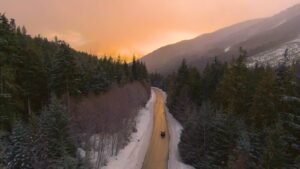Wildlife sanctuaries are places where animals thrive in their natural environments, offering you a unique chance to witness nature up close. This article explores the top sanctuaries to visit this year, covering their locations, notable wildlife, and essential tips for making the most of your experience.
Key Takeaways
-
British Columbia’s wildlife sanctuaries, such as the Chilcotin Ark and Creston Valley Wildlife Management Area, are key biodiversity hotspots that offer diverse ecosystems and significant wildlife viewing opportunities.
-
Visitors to wildlife sanctuaries can enhance their experience by utilizing facilities like visitor centers, participating in volunteer programs, and adhering to guidelines that protect the fragile environments.
-
Spring and autumn are the peak seasons for observing migratory birds in British Columbia’s sanctuaries, while summer provides opportunities to see wildflowers, and winter showcases animals in refuge.
Discovering Wildlife Sanctuaries in British Columbia
British Columbia boasts some of the most diverse and expansive nature reserves in the world. The Chilcotin Ark, for example, covers an impressive 2.5 million hectares, featuring ecosystems ranging from dense rainforests to alpine tundra. This extensive area shelters wildlife such as grizzly bears, cougars, and culturally significant wild horses, revered by local Indigenous communities.
Creston Valley Wildlife Management Area is another gem, a 7,000-hectare wetland habitat just 11 kilometers west of Creston. Home to over 300 bird species and nearly 60 mammal species, it is a biodiversity hotspot. Visitors can explore a network of trails, boardwalks, and bird towers, which facilitate wildlife observation and appreciation.
Creston Valley is renowned for its birdwatching opportunities. The Board Walk Loop and Song Bird Stroll lead to a bird tower, ideal for glimpsing painted turtles and various bird species. Annually attracting over 35,000 visitors, this sanctuary is a key destination for wildlife enthusiasts.
Conservation is crucial in these areas. Organizations such as the Chilcotin Ark Institute focus on research and conservation to safeguard these ecosystems and their inhabitants for future generations.
How to Reach Popular Wildlife Sanctuaries
Traveling to these sanctuaries is an adventure in itself. The George C. Reifel Migratory Bird Sanctuary, located 13 km west of Ladner in Delta, is accessible via Ladner Trunk Road and River Road. Reservations for parking are required and can be made three days in advance. Since public transit is unavailable, a personal vehicle is necessary.
Christmas Hill, another significant nature reserve, is just a 10-minute drive from downtown Victoria, east of Highway #17. Besides being an ecological treasure, it holds historical importance within the traditional territory of the Songhees people. Public transport users can take bus services from downtown Victoria, followed by a short walk to reach the reserve.
These routes lead to beautiful sanctuaries and offer scenic drives through diverse landscapes, making the journey as enjoyable as the destination. Whether by car or bus, traveling the Nordel Way to these protected lands is a prelude to the natural wonders that await.
What to Expect at a Wildlife Sanctuary
Visitors arriving at a wildlife sanctuary can expect various facilities to enhance their experience. Most sanctuaries feature visitor centers with restrooms, information desks, and picnic shelters, often serving as the starting point for exploring and providing valuable information about the area and its wildlife.
Wildlife viewing is optimal early in the morning or late in the afternoon when animals are most active. Many sanctuaries have designated bird-watching areas with observation blinds or platforms for close-up views of avian residents. Hiking trails are common, often featuring interpretive signs to educate visitors about the ecosystem and its species.
Many wildlife sanctuaries offer volunteer opportunities for those interested in giving back. Tasks range from habitat restoration and species monitoring to assisting with animal care. Participating in community events and fundraisers also supports these vital conservation areas.
Wildlife You Might Encounter
British Columbia’s wildlife sanctuaries teem with diverse species. Burns Bog, for instance, is home to over 300 distinct plant and animal species. Visitors might spot beavers living in banks instead of traditional lodges, or glimpse over 4,000 invertebrate species inhabiting the area.
Bird enthusiasts will find the Delta Nature Reserve especially rewarding. This area supports over 175 bird species, including songbirds, woodpeckers, hawks, and eagles. The Greater Sandhill Crane, a notable resident, often appears in the bog, enhancing the birdwatching experience.
Other wildlife includes various mammals, amphibians, and unique plant species. In Burns Bog, visitors might encounter carnivorous plants like sundews and rare cloudberries. The bog is also a crucial stopover for migratory birds on the Pacific Flyway, making spring and autumn particularly rewarding for birdwatching.
Guidelines for Visiting Wildlife Sanctuaries
Visiting a wildlife sanctuary requires following specific guidelines to protect the environment and ensure safety for all. Dogs must be kept on a leash at all times, and owners must clean up after them to avoid fines. Only designated service animals are permitted inside sanctuary buildings.
Staying on marked paths is essential to prevent damage to delicate ecosystems and protect wildlife habitats. Following these guidelines helps maintain the sanctuaries’ natural beauty and ensures these protected areas can be enjoyed by future generations.
Top Wildlife Sanctuaries in Metro Vancouver

Metro Vancouver offers some of the most accessible and ecologically significant wildlife sanctuaries. The Delta Nature Reserve is a prime example, providing public access to a portion of Burns Bog. Spanning 148 acres, this reserve features boardwalks for exploring the unique bog ecosystem.
Burns Bog is an ecological conservancy area covering about 3,000 hectares in the Fraser River delta, known for its unique ecological attributes. As the largest undeveloped urban landmass in North America, Burns Bog plays a crucial role in regional biodiversity and serves as a nesting site for the Sandhill Crane, supported by the Burns Bog Conservation Society.
These sanctuaries are managed to maintain their natural ecosystems, providing a safe haven for various plant and animal species. Visiting these areas offers a rare chance to connect with nature and witness firsthand the incredible biodiversity that British Columbia offers.
Seasonal Highlights and Best Times to Visit
The best times to visit wildlife sanctuaries in British Columbia often depend on what you hope to see. Spring and autumn are peak seasons for bird migration, making them particularly rewarding for birdwatching. During these seasons, you can observe various migratory birds as they travel along the Pacific Flyway.
Summer is ideal for spotting vibrant wildflowers and active nesting sites, while winter offers the unique chance to observe migratory birds flocking to specific refuges during the colder months. However, sections of wildlife refuges may be temporarily closed to protect wildlife or due to weather conditions.
Facilities and Amenities at Wildlife Sanctuaries
Visitors to wildlife sanctuaries can expect various facilities and amenities for a comfortable visit. A parking lot is generally available, but all visitors must exit by 4 pm. Restrooms and visitor centers with picnic shelters are common, providing a convenient base for exploring the sanctuary.
Bringing personal items like water bottles is advisable, especially when visiting areas like Burns Bog where amenities might be limited. These preparations ensure an enjoyable visit and allow you to fully immerse yourself in the sanctuary’s natural beauty.
Supporting Conservation Efforts
Supporting wildlife sanctuaries extends beyond just visiting them. Donations play a crucial role in maintaining these areas, and contributions can be made as one-time gifts or recurring donations. Businesses can also support sanctuaries by organizing fundraising events or donating a portion of their sales.
Volunteering is another impactful way to contribute. Many sanctuaries offer volunteer programs where you can assist with wildlife care, habitat restoration, and other conservation efforts. Remote volunteering options, such as sharing updates on social media or offering skills like website development, are also valuable.
Educational programs and guided tours offered by sanctuaries help raise awareness about conservation and wildlife protection. Participating in these programs and advocating for animal-friendly legislation can contribute to preserving these precious ecosystems for future generations.
Summary
Exploring the wildlife sanctuaries of British Columbia offers a unique and enriching experience. From the vast Chilcotin Ark to the serene wetlands of the Creston Valley, these nature reserves showcase the incredible biodiversity of Canada. By visiting these sanctuaries, you not only get to witness the beauty of nature but also contribute to the preservation of these vital ecosystems.
We encourage you to plan a visit, adhere to the guidelines, and consider supporting conservation efforts. Together, we can ensure that these sanctuaries remain a haven for wildlife and a source of inspiration for generations to come.
Frequently Asked Questions
Are dogs allowed in wildlife sanctuaries?
Dogs are generally allowed in wildlife sanctuaries as long as they are on a leash and owners clean up after them. It is crucial to adhere to these regulations to prevent potential fines.
What are the best times to visit for birdwatching?
The best times for birdwatching are during spring and autumn, as these seasons coincide with peak bird migration.
How can I support wildlife sanctuaries?
To effectively support wildlife sanctuaries, consider donating, volunteering your time, or engaging in educational programs. These actions contribute significantly to the conservation efforts and well-being of the animals.
What facilities are available at wildlife sanctuaries?
Wildlife sanctuaries typically offer visitor centers equipped with restrooms, information desks, and picnic shelters, along with ample parking facilities. These amenities enhance the visitor experience while enjoying nature.
Are public transport options available to reach wildlife sanctuaries?
Public transport options may be available for some wildlife sanctuaries, but many require a personal vehicle for access. It is advisable to check specific routes and services beforehand.






